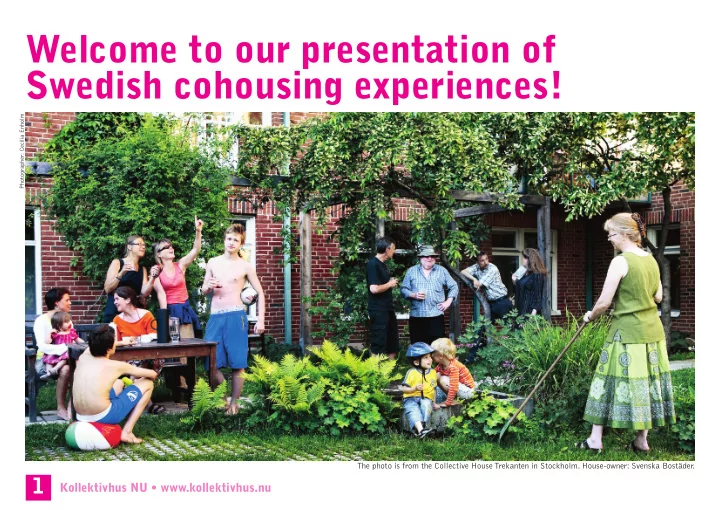

Welcome to our presentation of Swedish cohousing experiences! Photographer: Cecilia Enholm The photo is from the Collective House Trekanten in Stockholm. House-owner: Svenska Bostäder. 1 Kollektivhus NU • www.kollektivhus.nu
Snapshots from our history • Equality between men and women has been a major aim of the Swedish cohousing models. Common meals and other services were designed to reduce the burden of house work to make it possible to combine gainful employment with family life. • From the 1930s to the 1970s seventeen collective houses were built according to a model based on services through employed staff. • From 1980 this model was replaced by a model based on the residents’ own work. Fifty such units were built in the 1980s. The book where the new self-work model was presented 1982. 2 Kollektivhus NU • www.kollektivhus.nu
In the Swedish context, ’cohousing’ covers • full-fledged collectives (mainly urban, a few rural) • eco-villages; normally separate dwellings united in eco-schemes collective houses , designed to combine fully equipped private • apartments with collective living space In total, these make up only a minute fraction of the housing market. The umbrella organization Kollektivhus NU strives to inform the public about the advantages of cohousing and create a more visible consumer demand, and to stimulate housing companies to see cohousing as a viable alternative. 3 Kollektivhus NU • www.kollektivhus.nu
Today, there are around 44 functioning collective houses – as recorded by the umbrella organization Kollektivhus NU, and they – • have, and make use of, space and equipment for collective cooking and joint meals, with responsibility for cooking shared between their members, Photographer: Kerstin Kärnekull • collectively manage a variety of other joint amenities such as guestroom(s), washing machines, living room, media (journals,TV, computers), workshop, sauna etc. 4 Kollektivhus NU • www.kollektivhus.nu
These collective houses • were mainly created during the 1980s, with a new wave beginning in the late 90s • are located in urban areas • are by and large new housing units, built by housing companies, most of them municipal companies (parastatals) • represent most forms of occupation: individual tenancy (most frequent solution), cooperative tenancy, and cooperative ownership • vary greatly in size, from less than 10 to more than 180 flats (i.e.households) • vary in degree of collective organization (though all have collective space in addition to the private flats) 5 Kollektivhus NU • www.kollektivhus.nu
During the 1990s, a collective Photographer: Kerstin Kärnekull house form designed for ‘the second half of life’ came to life • This version was designed to serve the needs of people in the second half of life – 40 years or older, with no children in the household. It attracts not least senior citizens who prefer a moderate level of collectivity. • Of the 44 collective houses, 8 belong to this category, and more are to come. Politicians see them as an answer to the ‘aging’ of the population and senior citizens’ needs for togetherness and security. Buffét at Färdknäppen, Stockholm. House-owner: Familjebostäder. 6 Kollektivhus NU • www.kollektivhus.nu
Cohousing units in Sweden Vialen I Luleå Most of the cohouses are found in Stockholm, Södra Stations kollektivhus, Göteborg and Lund- Södermalm Trekanten, Liljeholmen Svärdet, Södermalm, Blomstret Tersen Malmö and a few other Taljan, Södermalm I Falun I Gävle Tullstugan, Södermalm university cities. Hässelby Familjehotell Sockenstugan, Skarpnäck Blenda Sjöfarten, Hammarby Sjöstad Elfvinggården, Bromma I Uppsala Påängen Cigarrlådan, Farsta Lergöken, Södertälje Kupan, Älvsjö I Stockholm I Örebro Undersammatak Fristad, Spånga Ängviksgården,Värmdö Vildsvinet Majbacken bogemenskap, EKBO/Gebers, Sköndal Vildkornet (Vårbrodden), Majorna Vällingby Tunnan Dunderbacken, Axelsberg I Linköping Kornet, Bo i gemenskap, Fässberg, Mölndal Fullersta Backe, Huddinge I Borås Färdknäppen, Södermalm I Göteborg Stolplyckan Trädet, Kortedala Prästgårdshagen, Älvsjö KOMBO, södra Stockholm Stacken, Bergsjön I Rental Orion (4 pkthus), Hägersten Slånbäret Solhem, Älmsta,Väddö I Växjö I Condominiums Tre Portar, Skarpnäck Utkiken, Södermalm Fortuna I Cooperativ rental Sämjan Rio, Gärdet I Planned units Regnbågen I Helsingborg I Landskrona Yxan Fiolen I Lund I Malmö Slottet Russinet BoAktiv Landgången, Bunkeflostrand 7 Kollektivhus 2010, Malmö Kollektivhus NU • www.kollektivhus.nu
Common to the Swedish Photographer: Ingrid Sillén collective houses are • that they are run by municipal housing companies in collaboration with a residents' organisation with an elected board, regular meetings and democratic decision-making processes • that in most of them, the residents have Children do the cooking at Södra Station, Stockholm. entered agreements to share – irrespective of sex – defined common tasks such as cooking, cleaning and administration • that joint meals are offered between one and seven days a week. 8 Cultivators at Fullersta Backe, Huddinge. House-owner: Huge Fastigheter AB Kollektivhus NU • www.kollektivhus.nu
No victory is certain! Challenges faced by the collective houses are: • That, in relation to the landlord, cohousing tenants succeed in maintaining a degree of control over the selection of new tenants • That the landlord is made to understand and support the needs linked to this form of tenancy • That, in the case of private or cooperate ownership, the collective house can establish and successfully defend its character in the face of market competition for urban housing Tullstugan, Stockholm Tersen, Falun Stolplyckan, Kornet, Mölndal Majbacken, Göteborg Regnbågen, Lund Tunnan, Borås Slottet, Lund Linköping 9 Kollektivhus NU • www.kollektivhus.nu
How do we ensure that progress is secured? • by influencing public opinion to see and realize that cohousing generally enables a freedom of choice that does not exist in conventional housing, a kind of luxury living that offers many spatial and social possibilities. • by making politicians, technicians and managers of housing companies accept the social and practical values of collective houses, in particular for single parents, families with children and senior people. Party at Blenda, Uppsala. Meeting at Tullstugan, Stockholm. Cake-party,Tre Portar, Skarpnäck. Building construction,Tersen, Falun. The Exhibition is sponsored by Dick Urban Vestbro, chairman, Kollektivhus NU 10 Kollektivhus NU • www.kollektivhus.nu Produced by: Bertil Egerö, Elsa Grip and Ingrid Sillén, 2010 • e-mail Kollektivhus NU: kollektivhus.nu@gmail.com
Recommend
More recommend